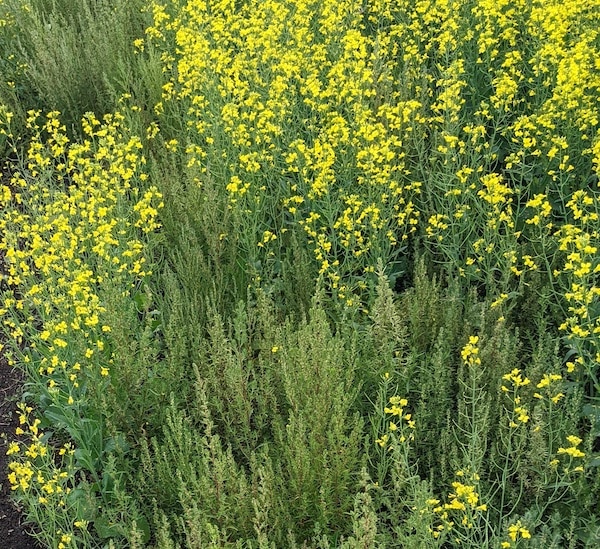Key Result
The economic and action thresholds for glyphosate-resistant kochia in canola in wester Canada were about double when canola was seeded at a target density of 100 compared with 50 plants m-2. Higher canola stand densities can help mitigate yield loss due to kochia interference at low-to-moderate kochia densities but not at very high kochia densities.
Project Summary
Overview
Kochia can be a problematic tumbleweed in western Canada, and in this region glyphosate-resistant kochia it now more common than glyphosate-susceptible. Glyphosate-resistant kochia was found in 14% and 52% of the sampled canola fields in recent surveys of Alberta (2017) and Manitoba (2018), respectively. If these uncontrolled kochia plants are present in canola at sufficient density, a second post-emergence herbicide application may be warranted, making stacked-trait canola varieties a valuable tool for kochia management.
New canola varieties with stacked traits that confer glyphosate (Roundup) and glufosinate (Liberty) resistance provide farmers with greater weed control flexibility by allowing for post-emergence application of glyphosate or glufosinate in a two-pass system (not mixed together). In many cases, however, a second weed control pass in canola is not warranted based on the critical period for weed control. This second pass can serve to manage weeds that are resistant to – or have emerged after – the first pass. However, unless these weeds are present at sufficient density to manifest yield losses, the second weed control pass represents an economic loss for farmers, while also causing unnecessary pesticide load on the environment, and greater selection for resistance to multiple herbicide modes-of-action.
Updated recommendations for lower canola target densities help farmers save money on seed costs, but little information is available to understand how these recommendations impact selection pressure for herbicide-resistant weeds. Furthermore, lower canola stand densities could be more susceptible to weed-induced yield loss, while higher stand densities could compete with weeds, and reduce weed seed production and return to the soil seedbank.
Purpose
This project aims to determine the economic, action, and seed production thresholds for glyphosate-resistant kochia in canola planted at five versus ten plants per square foot. Understanding these thresholds will aid in management decisions regarding a two-pass herbicide strategy in canola with stacked resistance to glyphosate and glufosinate, and further our understanding of the weed management implications of current canola stand density recommendations.
This study will provide canola farmers with the information required to determine when a two-pass program is warranted and economically viable. Determining the economic, action, and seed production thresholds for glyphosate-resistant kochia in canola will help farmers with decision making, save time and money, and reduce the potential detriments of unnecessary herbicide use on the environment. Little information is available to support decisions regarding a two-pass glyphosate/glufosinate herbicide program in canola.
Updated recommendations for lower target canola plant densities help farmers save money on seed costs, while also maintaining yield potential under weed-free conditions. However, we do not fully understand how these canola densities impact competition with weeds, selection pressure for herbicide resistance, and yield loss caused by weeds. In the Canadian Prairies, potential yield losses by uncontrolled weeds in canola are estimated to reach 32% yield loss on average (Soltani et al. 202Xa, In Prep.). As in other crops (Geddes and Gulden 2018; Mohler 2001), lower canola density could result in greater yield losses under weed competition. However, high phenotypic plasticity in canola could also mitigate reduced competitiveness at lower densities (Angadi et al. 2003). Therefore, investigation of the potential implications of canola stand density on weed competition, selection pressure for herbicide resistance, and potential yield losses is warranted.

Objectives
The objectives of this project are to:
1) Determine the economic threshold for glyphosate-resistant kochia in canola.
2) Determine the action threshold for glyphosate-resistant kochia in canola.
3) Determine whether canola density impacts the economic, action, and seed production thresholds for glyphosate-resistant kochia.
4) Determine the impact of canola density and kochia density on kochia seed production and return to the soil seedbank.
Experiments
A field experiment was conducted to determine the economic and action thresholds for glyphosate-resistant kochia in canola. The nine site-years of research included irrigated locations near Lethbridge, AB (2022, 2023i & 2023ii), and rainfed locations near Lethbridge, AB (2022 & 2023), Scott, SK (2022 & 2023), and Carman, MB (2023i & 2023ii). The experiment followed a two-way factorial randomized complete block design with four replicates. The factors were canola target density (50 vs. 100 plants m-2; about 5 vs. 10 plants per square foot) and kochia density (nine seeding rates ranging from 0 to 7290 seeds m-2).
Results
Among site-years, the canola target densities of 50 and 100 plants m-2 resulted in observed plant densities of 53 and 98 plants m-2, respectively. At low kochia densities, each additional kochia plant m-2 resulted in about double the canola yield loss when canola was seeded at 50 target plants m-2 (I = 0.80% yield loss per kochia plant per m2) compared with 100 target plants m-2 (I = 0.43% yield loss per kochia plant per m2). However, the predicted maximum yield loss due to kochia competition at high densities did not differ significantly between canola target densities (A = 32.1 ± 3.8% vs. 33.8 ± 4.4% maximum yield loss).
The 5% action threshold, otherwise known as the density of kochia causing 5% canola yield loss, was 7.3 kochia plants m-2 at canola target densities of 50 plants m-2 and 13.7 kochia plants m-2 at canola target densities of 100 plants m-2. The 5% action threshold corresponded with both low ($50 ha-1 or $20 ac-1) and high ($75 ha-1 or $30 ac-1) economic thresholds where the thresholds were almost double when canola was seeded at a target density of 100 compared with 50 plants m-2.
Taken together, these results suggest that seeding canola at higher target densities results in greater economic and action thresholds for glyphosate-resistant kochia. Thus, higher canola target densities can help mitigate yield loss due to kochia competition at low-to-moderate kochia densities, however, the maximum yield loss at high kochia densities did not differ based on canola seeding rate.
Conclusions
In conclusion, the economic and action thresholds for glyphosate-resistant kochia in canola were about double when canola was seeded at a target density of 100 compared with 50 plants m-2 across nine site-years of research in western Canada. Higher canola stand densities can help mitigate yield loss due to kochia interference at low-to-moderate kochia densities but not at very high kochia densities.
References
- Angadi, S.V., Cutforth, H.W., McConkey, B.G., and Gan, Y. 2003. Yield adjustment by canola grown at different plant populations under semiarid conditions. Crop Science 43:1358-1336.
- Geddes, C.M., and Gulden, R.H. 2018. Candidate tools for integrated weed management in soybean at the northern frontier of production. Weed Science 66:662-672.
- Mohler, C.L. 2001. Chapter 6: Enhancing the competitive ability of crops. Pages 269-231 in Ecological Management of Agricultural Weeds (eds. M. Liebman, C.L. Mohler & C.P. Staver). Cambridge University Press, Cambridge, UK.
- Soltani, N., Geddes, C.M., Tidemann, B.D., Sikkema, P.H. 202Xa. Potential yield loss in canola crops due to weed interference in Canada and the United States. Manuscript in preparation for Weed Technology. Writing stage.





